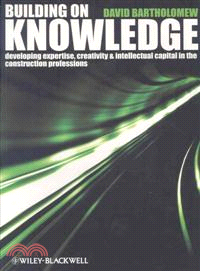Building On Knowledge
商品資訊
ISBN13:9781405147095
出版社:John Wiley & Sons Inc
作者:Bartholomew
出版日:2008/09/19
裝訂/頁數:平裝/320頁
定價
:NT$ 4786 元優惠價
:90 折 4307 元
若需訂購本書,請電洽客服 02-25006600[分機130、131]。
商品簡介
作者簡介
目次
相關商品
商品簡介
This guide shows design practices and other construction professionals how to manage knowledge successfully. It explains how to develop and implement a knowledge management strategy, and how to avoid the pitfalls, focusing on the techniques of learning and knowledge sharing that are most relevant in professional practice. Expensive IT-based ‘solutions’ bought off-the-shelf rarely succeed in a practice context, so the emphasis here is on people-centred techniques, which recognise and meet real business knowledge needs and fit in with the organisational culture.
Knowledge is supplanting physical assets as the dominant basis of capital value and an understanding of how knowledge is acquired, shared and used is increasingly crucial in organisational success. Most business leaders recognise this, but few have yet succeeded in making it the pervasive influence on management practice that it needs to become; that has turned out to be harder than it looks.
Construction professionals are among those who have furthest to go, and most to gain. Design is a knowledge-based activity, and project managers, contractors and clients, as well as architects and engineers, have always learned from experience and shared their knowledge with immediate colleagues. But the intuitive processes they have traditionally used break down alarmingly quickly as organisations grow; even simply dividing the office over two floors can noticeably reduce communication. At the same time, increasingly sophisticated construction technology and more demanding markets are making effective management of knowledge ever more important. Other knowledge-intensive industries (such as management consultancy, pharmaceuticals, and IT), are well ahead in adopting a more systematic approach to learning and sharing knowledge, and seeing the benefits in improved technical capacity, efficiency, customer satisfaction and reduced risk.
Knowledge is supplanting physical assets as the dominant basis of capital value and an understanding of how knowledge is acquired, shared and used is increasingly crucial in organisational success. Most business leaders recognise this, but few have yet succeeded in making it the pervasive influence on management practice that it needs to become; that has turned out to be harder than it looks.
Construction professionals are among those who have furthest to go, and most to gain. Design is a knowledge-based activity, and project managers, contractors and clients, as well as architects and engineers, have always learned from experience and shared their knowledge with immediate colleagues. But the intuitive processes they have traditionally used break down alarmingly quickly as organisations grow; even simply dividing the office over two floors can noticeably reduce communication. At the same time, increasingly sophisticated construction technology and more demanding markets are making effective management of knowledge ever more important. Other knowledge-intensive industries (such as management consultancy, pharmaceuticals, and IT), are well ahead in adopting a more systematic approach to learning and sharing knowledge, and seeing the benefits in improved technical capacity, efficiency, customer satisfaction and reduced risk.
作者簡介
David Bartholomew has been managing knowledge for over 25 years as a director of research, a business manager, a Royal Academy of Engineering Visiting Professor at De Montfort University and a consultant on innovation.
目次
Preface .
Part I Foundations.
1 Introduction.
Paradoxical professionals.
New context, new issues.
What is in this book.
2 Knowledge at Work .
How we learn.
What makes an expert.
Varieties of knowledge.
Putting the pieces together.
3 Strategic Frameworks.
Starting points.
Frameworks for thinking.
Finding conviction.
4 The Challenges of Change.
Why initiatives fail.
Difficulty is normal.
5 Leadership and Other Roles.
Action starts where the buck stops.
Practical leadership.
Other roles.
Knowledge-conscious management.
6 Knowledge Audit and Beyond.
Finding square one.
Audit techniques.
From audit to action plan.
Putting plans into practice.
Part 2 Tools & techniques.
7 The Knowledge-Friendly Office.
Environments matter.
Designing the knowledge-friendly office.
Workplaces for teams.
8 Expanding Networks.
It’s not what you know ….
Help from IT.
Designing networking tools.
9 Learning from Peers.
See one, do one, teach one.
Mentoring in different contexts.
10 Learning from Practice.
Practice: the invisible lab and unsung teacher.
Windows of opportunity.
Foresight: learning from invention.
Hindsight: learning from mistakes — and success.
Choosing cases.
11 Communities of Practice.
Encouraging enthusiasts.
Creating communities.
12 Organisational Memory.
The indispensability of writing.
Deciding what to record, and how.
Capturing knowledge.
Documenting knowledge.
Software frameworks.
13 Personal Knowledge Management.
Equipment for the mind gym.
Developing personal expertise.
Building a bionic memory.
14 Synergies.
IT-enabled synergies.
Creating and sharing knowledge.
Multiple synergies.
Part 3 Knowledge Management in Practice.
15 Introduction to the Case Studies.
16 Aedas.
17 Arup.
18 Broadway Malyan.
19 Buro Happold.
20 ECA.
21 FCB.
22 P&P.
23 Whitbybird.
24 WSP.
25 Foresight and Hindsight.
Epilogue: Where Next for Knowledge Management? .
Further reading
Part I Foundations.
1 Introduction.
Paradoxical professionals.
New context, new issues.
What is in this book.
2 Knowledge at Work .
How we learn.
What makes an expert.
Varieties of knowledge.
Putting the pieces together.
3 Strategic Frameworks.
Starting points.
Frameworks for thinking.
Finding conviction.
4 The Challenges of Change.
Why initiatives fail.
Difficulty is normal.
5 Leadership and Other Roles.
Action starts where the buck stops.
Practical leadership.
Other roles.
Knowledge-conscious management.
6 Knowledge Audit and Beyond.
Finding square one.
Audit techniques.
From audit to action plan.
Putting plans into practice.
Part 2 Tools & techniques.
7 The Knowledge-Friendly Office.
Environments matter.
Designing the knowledge-friendly office.
Workplaces for teams.
8 Expanding Networks.
It’s not what you know ….
Help from IT.
Designing networking tools.
9 Learning from Peers.
See one, do one, teach one.
Mentoring in different contexts.
10 Learning from Practice.
Practice: the invisible lab and unsung teacher.
Windows of opportunity.
Foresight: learning from invention.
Hindsight: learning from mistakes — and success.
Choosing cases.
11 Communities of Practice.
Encouraging enthusiasts.
Creating communities.
12 Organisational Memory.
The indispensability of writing.
Deciding what to record, and how.
Capturing knowledge.
Documenting knowledge.
Software frameworks.
13 Personal Knowledge Management.
Equipment for the mind gym.
Developing personal expertise.
Building a bionic memory.
14 Synergies.
IT-enabled synergies.
Creating and sharing knowledge.
Multiple synergies.
Part 3 Knowledge Management in Practice.
15 Introduction to the Case Studies.
16 Aedas.
17 Arup.
18 Broadway Malyan.
19 Buro Happold.
20 ECA.
21 FCB.
22 P&P.
23 Whitbybird.
24 WSP.
25 Foresight and Hindsight.
Epilogue: Where Next for Knowledge Management? .
Further reading
主題書展
更多
主題書展
更多書展今日66折
您曾經瀏覽過的商品
購物須知
外文書商品之書封,為出版社提供之樣本。實際出貨商品,以出版社所提供之現有版本為主。部份書籍,因出版社供應狀況特殊,匯率將依實際狀況做調整。
無庫存之商品,在您完成訂單程序之後,將以空運的方式為你下單調貨。為了縮短等待的時間,建議您將外文書與其他商品分開下單,以獲得最快的取貨速度,平均調貨時間為1~2個月。
為了保護您的權益,「三民網路書店」提供會員七日商品鑑賞期(收到商品為起始日)。
若要辦理退貨,請在商品鑑賞期內寄回,且商品必須是全新狀態與完整包裝(商品、附件、發票、隨貨贈品等)否則恕不接受退貨。
























